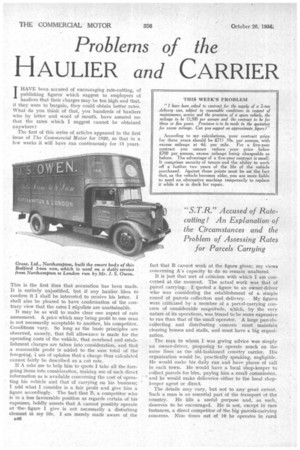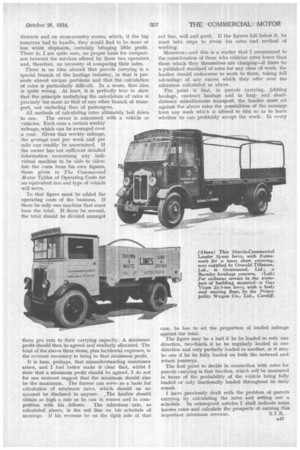Problems of the
Page 60

Page 61

If you've noticed an error in this article please click here to report it so we can fix it.
HAULIER and CARRIER IHAVE been accused of encouraging rate-cutting, of publishing figures which suggest to employers of hauliers that their charges may be too high and that, if they were to bargain, they could obtain better rates. What do you think of that, you hundreds of hauliers who by letter and word of mouth, have assured me that the rates which I suggest cannot be obtained anywhere?
The first of this series of articles appeared in the first issue of The Commercial Motor for 1920, so that in a few weeks it will have run continuously for 15 years.
This is the first time that accusation has been made. It is entirely unjustified, but if any hauliir likes to confirm it I shall be interested to receive his letter. I shall also be pleased to have confirmation of the contrary view that the rates I stipulate are unattainable.
It may be as well to make clear one aspect of rate assessment. A price which may bring profit to one man is not necessarily acceptable to another, his competitor.. Conditions vary. So long as the basic principles are observed, namely, that full *allowance is made for the operating costs of the vehicle, that overhead and establishment charges are taken into consideration, and that a reasonable profit is added to the sum total of the foregoing, I am of opinion that a charge thus calculated cannot fairly be described as a cut rate.
If A asks me to help him to quote I take all the foregoing items into consideration, making use of such direct information as is available concerning the cost of operating his vehicle and that of carrying on his business; I add what I consider is a fair profit and give him a figure accordingly. The fact that B, a competitor who is in a less favourable position as regards certain of his expenses, boldly asserts that A cannot possibly operate at -the'. figure I give is not necessarily a disturbing element in my life. I am merely made aware of the
B46 fact that B cannot work at the figure given; my views concerning A's capacity to do so remain' unaltered.
It is just that sort of criticism with which I am concerned at the moment. The actual work was that of parcel carrying. I quoted a figure to an owner-driver who was considering the establishment of a 'simple round of parcels collection and delivery. My figures were criticized by a member of a parcel-carrying concern of considerable magnitude, which, by the very nature of its operations, was bound to be more expensive to run than that of the small operator. A large parcelscollecting and distributing concern must maintain clearing houses and staffs, and must have a big organization.
The man to whom I was giving advice was simply an owner-driver, proposing to operate much on the same lines as the old-fashioned country carrier. His organization would be, practically speaking, negligible. He Would make his daily run and have places of call in each town. He would have a local shop-keeper to collect parcels for him, paying him a small commission, and he would make deliveries either to the local shopkeeper agent or direct.
The details may vary, but not to any great extent. Such a man is an essential part of the transport of the country. He fills a useful purpose and, as such, deserves to be encouraged. Be is not, except in rare instances, a direct competitor of the big parcels-carrying concerns. Nine times out of 10 he operates in rural districts and on cross-country routes, which, if the big concerns had to handle, they would find to be more or less white elephants, certainly bringing little profit. There is, I am quite sure, no proper basis for comparison between the services offered by these two operators and, therefore, no necessity of comparing their rates.
There is an idea abroad that parcels carrying is a special branch of the haulage industry, in that it presents almost unique problems and that the calculation of rates is particularly difficult. In a sense, that idea is quite wrong. At least, it is perfectly true to state that the principle underlying the calculation of rates is precisely the same as that of any other branch of transport, not excluding that of passengers.
All methods of calculating rates ultimately boil down to one. The owner is concerned with a vehicle or vehicles. Each runs a certain weekly mileage, which can be averaged over a year. Given that weekly mileage, the average cost per week and per mile can readily be ascertained. If the owner has not sufficient detailed information concerning any individual machine to be able to Calculate the costs from his own figures, those given in The Commercial Motor Tables of Operating Costs for an equivalent size and type of vehicle will serve.
To that figure must be added the operating costs of the business. If there be only one machine that must bear the total. If there be several, the total should be divided amongst them pro rata to their carrying capacity. A minimum profit should then be agreed and similarly allocated. The total of the above three items, plus incidental expenses, is the revenue necessary to bring in that minimum profit, It is here, perhaps, that misunderstanding sometimes arises, and I had better make it clear that, whilst I state that a minimum profit should be agreed, I do not for one moment suggest that the minimum should also be the maximum. The former can serve as a basis for calculation of minimum rates, which should on no account be disclosed to anyone. The haulier should obtain as high a rate as he can in reason and in com petition with his fellows. The minimum rate, as calculated above, is the red line on his schedule of earnings. If his revenue be on the right side of that red line, well and good. If the figures fall below it, he must take steps to revise his rates and method of working.
Moreover—and this is a matter that I recommend to the consideration of those who criticize rates lower than those which they themselves are charging—if there be a published standard of rates for any class of work, the haulier should endeavour to work to them, taking full advantage of any excess which they offer over the minimum calculated as above.
The point is that, in parcels carrying, jobbing haulage, contract haulage and in longand shortdistance miscellaneous transport, the haulier must set against the above rates the possibilities of the earnings from any work which is offered to him so as to learn whether he can profitably accept the work. In every
case, he has to set the proportion of loaded mileage against the total.
The figure may be a half if he be loaded in only one direction, two-thirds if he be regularly loaded in one direction and only partially loaded in another, or it may be one if he be fully loaded on both the outward and return journeys.
The first point to decide in connection with rates for parcels carrying is that fraction, which will be measured in terms of the probability of the vehicle being fully loaded or only fractionally loaded throughout its daily round.
I have previously dealt with the problem of parcels carrying by calculating the rates and setting out a schedule. In subsequent articles I shall indicate some known rates and calculate the prospects of earning this important minimum revenue. S.T.R.




























































































